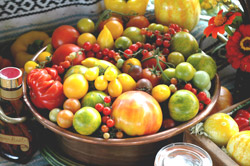
by Randel A. Agrella
Quality Modern vegetable breeding has yielded some useful varieties, but at a price: quality has been sacrificed to convenience in harvesting and shipping. Crops have been bred for uniformity, or to ripen all at once (simplifying mechanical harvesting), or to withstand rough handling. Quality, taste, and nutritional value have been casualties of this trend. Hybrid types often lack complexity and depth in their flavor, since appearance and shippability are so much more important under a mass-marketing paradigm. Tenderness and fine texture have also often fallen by the wayside. And, increasingly, studies are showing that the nutritional values in factory-farmed produce are actually lower. Agribusiness is okay with that, but agribusiness standards don’t apply in the home garden!
Performance: Despite heirlooms’ reputation for being finicky, this really needn’t be the case. Heirloom varieties are often the product of generations of careful selection by farmers and gardeners who knew what they wanted from their plants. If a variety has been carefully nurtured by generations of a family or in a small geographic area, it stands to reason that it must perform well in the conditions under which it has been preserved. So, by choosing varieties from your own area, or from similar climates, it’s possible to select varieties that will be vigorous and productive in your own garden.
Saving Seed: A great advantage of heirlooms is the fact that true-to-type seed may be saved for use in future years, and renewed year after year! You can’t do this with hybrids; if you save seed grown from hybrid parents, offspring will show wide variation and will usually be markedly inferior to the parents. In fact, careful selection in your own garden can actually produce a unique strain, resulting in even better performance under your unique conditions and methods!
Tradition & Continuity Heirloom
Vegetables represent a priceless legacy, the product of centuries of work by generations of farmers around the globe. When we grow heirlooms, we are the living link in the chain. We take our turn in a succession of growers, each generation of which cherished their favorite varieties and lovingly preserved fresh seed for coming years. As the current custodians, get to make our mark, passing on in turn the varieties we love most. Heirloom seeds are our living legacy, bequeathed to us from the past, and passed on to posterity!
Open-pollinated, hybrid, heirloom?
Gardeners are sometimes baffled by these terms, frequently seen in seed catalogs:
Open-pollinated: Seeds are produced in a stand whose members are similar, breeding freely by natural means. The genetic makeup of the parents is fairly uniform, so their offspring are also uniform. There is still some breeding work being done with open-pollinated varieties, especially within the heirloom community, utilizing existing heirlooms to yield new open-pollinated types.
Hybrid: Two quite different parents from highly inbred lines, are crossed under controlled conditions. Since the offspring carry genetic material from two different lines, if their seed is saved, the next generation reverts to something similar to the two parent lines, which may be quite different from each other, resulting in a lot of variation in the second generation. Many of the individual plants will be inferior to their parents.
Heirloom: Always open-pollinated, usually at least 50 years old. Some heirlooms may have been the product of university breeding in the days before hybrids were preferred, but often arose on an individual farm, within a particular family or group of people who shared their seeds.
For more information on Heirloom Seeds, please visit online at www.rareseeds.com or go to www.theheirloomexpo.com.


